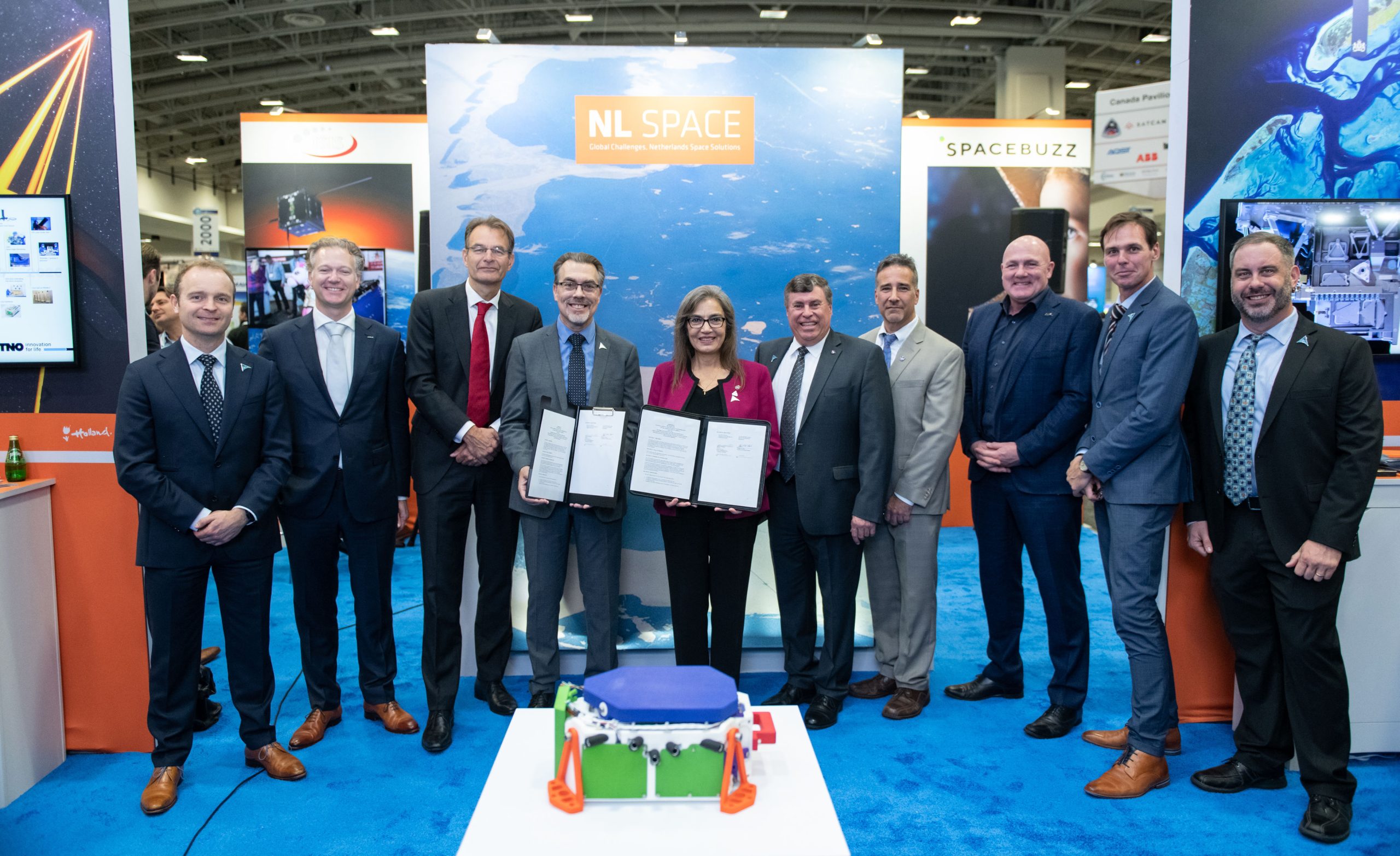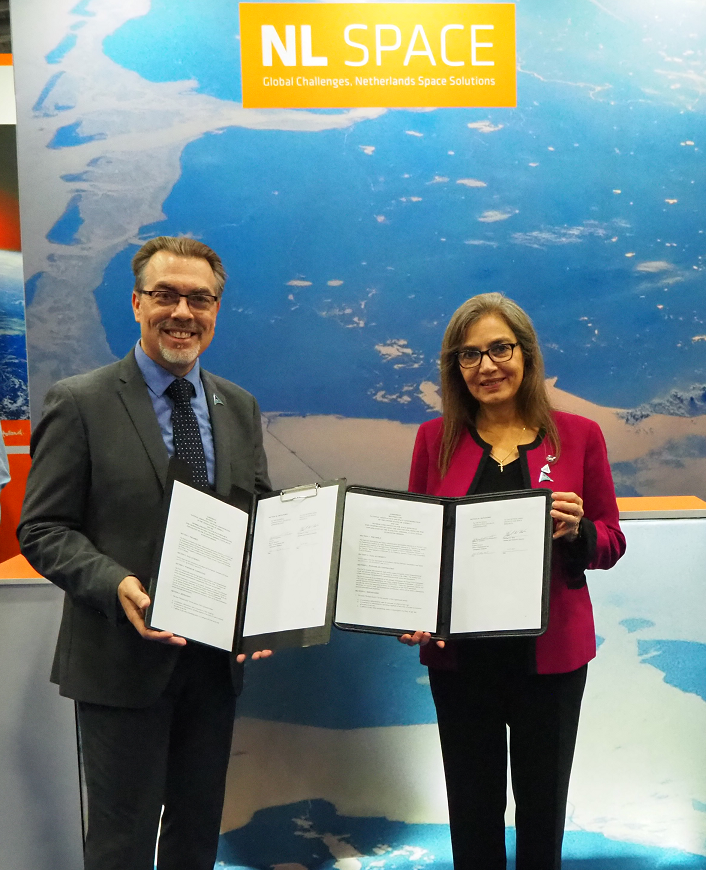NASA en een Nederlands ruimtevaartconsortium hebben hun samenwerking in het aardatmosfeeronderzoek bekrachtigd op het Nederlandse NL Space-paviljoen van het 70e International Astronautical Congress (IAC) in Washington DC. Ruimteonderzoekinstituut SRON en Airbus Defence and Space Netherlands ontwikkelen samen, ondersteund door TNO, het aerosol-instrument SPEXone voor NASA’s PACE-satelliet, die in 2022 wordt gelanceerd.

Van links naar rechts: Kees Buijsrogge (directeur TNO Space), Maarten Schippers (CEO Airbus Defence and Space Netherlands), André Haspels (NL ambassadeur in de VS), Michael Wise (algemeen en wetenschappelijk directeur SRON), Sandra Cauffman (NASA Headquarters), George Morrow (directeur NASA Goddard Space Flight Center), Andre Dress (PACE Project Manager, NASA), André Kuipers (astronaut), Harm van de Wetering (directeur NSO), Jeremy Werdell (onderzoeker, NASA). Credit: NASA Goddard/Taylor Mickal.
Met de ceremonie op de IAC vierden SRON-directeur Michael Wise en Sandra Cauffman, plaatsvervangend directeur van de Earth Sciences Division van NASA Head Quarters, de eerdere ondertekening van een overeenkomst die ertoe leidt dat het Nederlandse aerosolinstrument SPEXone straks meevliegt op het PACE (Plankton, Aerosol, Cloud & ocean Ecosystem) observatorium van NASA. PACE brengt verschillende factoren in kaart die in samenhang invloed hebben op het klimaat en heeft behalve SPEXone nog twee wetenschappelijke instrumenten aan boord: het Ocean Color Instrument OCI en de wolkenpolarimeter HARP-2.

Invloed aerosolen op klimaat ontrafeld
Aerosolen zijn kleine deeltjes als roet, as en woestijnstof in onze atmosfeer. Ze hebben grote invloed op klimaatverandering en luchtvervuiling, maar hun precieze rol is onvoldoende bekend. Zo weerkaatsen de meeste aerosolen licht, waardoor ze een afkoelend effect op de aarde hebben. Maar ze kunnen door absorptie ook een opwarmend effect hebben. SPEXone gaat de eigenschappen van aerosolen – zoals afmeting, samenstelling, vorm en hun absorberend en weerkaatsend vermogen – bepalen via de (de)polarisatie die de deeltjes aan het zonlicht geven terwijl ze het licht weerkaatsen. Om de relevante aerosol-eigenschappen te bepalen is het nodig om heel nauwkeurig de polarisatie te meten. SPEXone is hiertoe in staat door het toepassen van een nieuwe techniek; het instrument moduleert de polarisatietoestand van het invallende licht afhankelijk van de kleur, waardoor intensiteit en graad van polarisatie gelijktijdig kunnen worden gemeten als continue functie van de golflengte.
Over SpexOne
SPEXone wordt ontwikkeld door een Nederlands consortium bestaande uit ruimteonderzoeksinstituut SRON en Airbus Defence and Space Netherlands, daarbij ondersteund door opto-mechanische experts van TNO. SRON en Airbus DS NL zijn verantwoordelijk voor het ontwerp, de samenbouw en het testen van het instrument. De wetenschappelijke leiding ligt in handen van SRON. SPEXone is een publiek-privaat initiatief dat mogelijk gemaakt is door het NSO met door OCW beschikbaar gestelde middelen en door SRON-NWO met ondersteuning van Airbus.
NASA and Dutch space sector celebrate cooperation in Earth ecosystem research
NASA and the Dutch space sector celebrated their cooperation in the Earth’s ecosystem research at the 70th International Astronautical Congress (IAC) in Washington DC. SRON Netherlands Institute for Space Research and Airbus Defence and Space Netherlands, supported by TNO, together develop the aerosol instrument SPEXone that will fly on NASA’s PACE satellite, which will be launched in 2022.
With the ceremony at the IAC SRON director Michael Wise and Sandra Cauffman, acting director of the Earth Sciences Division of NASA Head Quarters, celebrated the agreement that will lead to the integration of the Dutch aerosol instrument SPEXone onto the PACE (Plankton, Aerosol, Cloud and ocean Ecosystem) observatory. PACE will study the various factors that affect the Earth’s ecosystem and atmosphere and will harbor two other scientific instruments besides SPEXone: main instrument OCI (Ocean Color Instrument) and cloud polarimeter HARP-2 (Hyper-Angular Rainbow Polarimeter).
Impact of aerosols on climate to be unraveled
Aerosols are small dust particles in the air such as soot, ash and desert dust in our atmosphere. They have a major influence on air pollution and climate change, but their precise role is insufficiently known. For example, most aerosols reflect light and have a cooling effect on the Earth, but they can also have a warming effect due to the absorption of sunlight.
SPEXone determines the polarization that aerosols cause while reflecting sunlight, which makes it possible to measure their properties (like size, composition, shape and their capability to absorb or reflect sunlight). In order to determine the relevant aerosol properties, it is necessary to measure the polarization very accurately. This is made possible by a new measuring technology, which is based on the polarization modulation concept that maps the linear polarization state onto the intensity spectrum. This allows us to measure both intensity and polarization simultaneously as a continuous function of wavelength.
About SPEXone
SPEXone is being developed by a Dutch consortium consisting of SRON Netherlands Institute for Space Research and Airbus Defence and Space Netherlands, supported by opto-mechanical expertise from TNO. SRON and Airbus DS NL are responsible for the design, manufacture and test of the instrument. The scientific lead is in the hands of SRON. SPEXone is a public-private initiative, made possible by NSO, with resources made available by the Dutch ministry of science and by SRON-NWO, with support from Airbus DS NL.
Present at the SPEXone ceremony, from left to right: Sandra Cauffman (acting director of the Earth Sciences Division of NASA Head Quarters), George Morrow (director NASA Goddard Space Flight Center), André Haspels (Dutch ambassador in the US), Harm van de Wetering (director Netherlands Space Office), Michael Wise (general and scientific director SRON), Maarten Schipper (CEO Airbus Defence and Space Netherlands), Kees Buijsrogge (director TNO Space), Jeroen Rotteveel (chairman SpaceNed) en André Kuipers (former astronaut).


